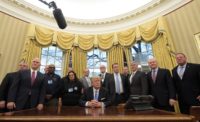While laborers and union leaders cheered President Donald Trump’s presidential memorandums paving the way for the Dakota Access and Keystone XL pipelines, it will take more than the stroke of a pen to get the projects restarted.
“The construction of the KXL and Dakota pipelines will help put thousands of Americans, including Teamster members, to work,” said Jim Hoffa, Teamsters general president in a statement.
Nearly all the hours on the $3.8-billion Dakota Access Pipeline project have been logged, and laborers are encouraged to see it move toward completion, says Kevin Pranis, LiUNA’s marketing manager for the Great Lakes region. “We got paid to build the pipeline, and we’d like to get that pipeline operating,” he says.
Union attention is turning toward Keystone XL and other proposed pipelines. “There are a lot of proposed projects out there,” says Glen Johnson, business manager at Operating Engineers Local 49 in West Fargo, N.D.
Before any final action will be taken, both lines will go through an expedited review using existing environmental assessments. Environmental and tribal groups have promised to fight the pipelines.
Justifying Previous Decisions
The presidential memorandum on the Dakota pipeline requires the Army Corps of Engineers to examine whether to rescind or modify a Dec. 4 memorandum that requires an exploration of alternative routes for the last section of the Dakota Pipeline under Lake Oahe. The Corps also called for a full environmental impact statement on the line.
John Eisenhauer, a senior adviser at Dawson and Associates and a former commander of the Corps’ Portland District, noted that, under the National Environmental Policy Act, the Corps can reverse its Dec. 4 decision but said “they are going to have to explain why” on legal grounds.
Construction of the line is being challenged by the Standing Rock Sioux tribe in a Washington, D.C., federal district court, and the tribe is hoping the court will stop the pipeline until a full EIS is complete.
“We maintain that to change course now would be arbitrary and without justification and would amount to political manipulation of our court system,” the Standing Rock Sioux said after a court status hearing on Jan. 30.
Market Forces and Keystone XL
Market forces and potential litigation make the future of the Keystone XL pipeline uncertain.
Pipeline developer TransCanada resubmitted its application to build the cross-border line just two days after Trump signed the memorandum ordering an expedited review of the line. The secretary of State has 60 days to review the application and determine whether the pipeline is in the national interest.
But, at an investor conference a day after the Trump order, TransCanada President and CEO Russ Girling fielded questions on whether Keystone still makes economic sense. “It’s really, really premature to speculate,” Girling said. In Nebraska, for instance, Keystone has no route and there is a fight over eminent domain.
Trump’s order requires the State Dept. to use the existing environmental impact statement in deciding on the line. But the Natural Resources Defense Council says the EIS is out of date. For example, to justify the economic benefit of the pipeline, it prices a barrel of oil at $100 to $140, rather than the current $50- to $60- per-barrel price.
Anthony Swift, director of NRDC’s Canada program, says Trump’s order “creates major legal uncertainties. The 60-day deadline doesn’t give time to give a reasonable analysis of the line or to allow the public to engage.”
LiUNA’s Pranis says the presidential orders are reasonable, will remove politics from pipeline permitting and provide a safe way to move oil.
“We’re not out there fighting to turn back the clock,” he said. “We’re fighting to move forward with a balanced approach to get our fuel and our energy needs in a way that’s sustainable.”




Post a comment to this article
Report Abusive Comment